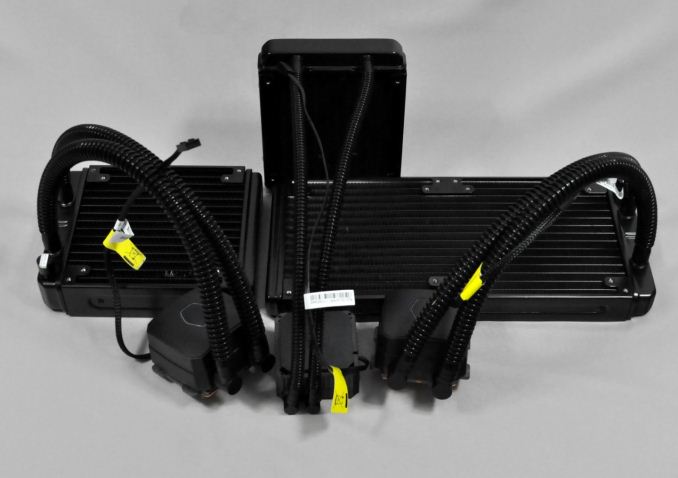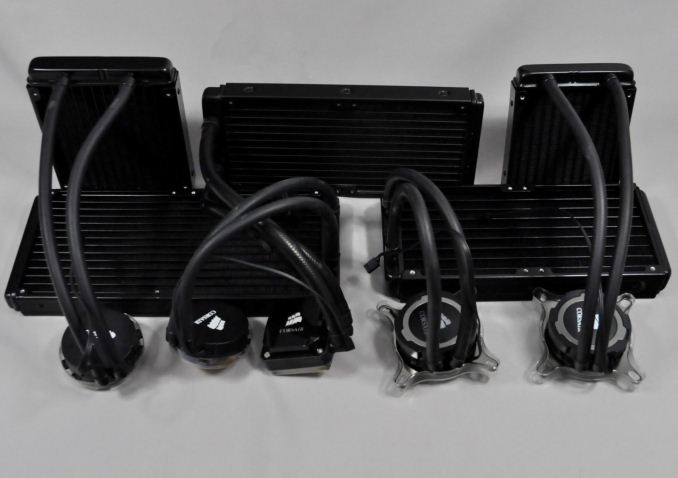Closed Loop AIO Liquid Coolers: 14-way Mega Roundup Review
by E. Fylladitakis on February 12, 2014 7:00 AM ESTCooler Master
It would seem that Cooler Master simply wanted to create the best performing AIO coolers available. In that respect, they certainly managed to do so, as their Nepton series coolers are constantly at the top of our high load thermal performance charts. On the other hand, one would have to be at least partially deaf in order to use these coolers with the fans anywhere near their maximum speed. Even with their voltage reduced down to 7V, both kits are rather noisy. It is not possible to run these kits quiet even if you reduce the voltage even further, as the fans are clearly audible from 1 meter away even at just 4.7V, the minimum voltage required to start them. Therefore, we simply cannot recommend them to anyone seeking a quiet cooling solution.
The Seidon 120V however is an entirely different product. Priced at just $49.99, it is more of an alternative to an average air cooler than competition for liquid cooling solutions. It fares relatively well at lower loads but its performance diminishes with thermal loads greater than 150W. With an average thermal resistance slightly above 0.014 °C/W, it will most likely be unable to compete with most extreme performance air coolers, and it has a particularly noisy pump, making it noisier than other 120mm AIO coolers. However, it has other merits, as it does not stress the motherboard with its weight and it requires very little space around the CPU area, making it ideal for special builds and/or systems that are moved around a lot.
Corsair
Corsair has such a vast selection of AIO cooling products that we could make a roundup just for them. Each of the five coolers that they shipped us for this roundup displays entirely different behavior; thus, each of them is suitable for a different type of user.
With the H75 Corsair is offering a compact 120mm AIO cooler but with two 120mm fans for extra performance. The H75 performs relatively well, although it generally does better at thermal loads lower than 150W due to the low capacity of its small radiator. The use of two fans however increases the noise of the system, giving the advantage to Enermax's Liqmax 120S if low-noise operation is the top priority.
The 140mm H90 on the other hand displays great all-around performance and very low noise levels. Even with its fan constantly running at maximum speed, the H90 can be considered fairly discreet and is comfortable for everyday use. If quiet computing is what drives you, the H90 deserves a very strong consideration.
Corsair informed us that the H100i is their most popular AIO cooler and we can see why. Despite its size, the H100i easily competes with coolers using significantly larger radiators. The stock fans have a wide operating range and the USB interface allows the user to adjust the performance/noise ratio to meet his or her exact needs. Furthermore, the size of the radiator makes the H100i compatible with a relatively wide array of cases.
After looking at the performance figures of the H100i, we felt disappointed by the performance of the newly released H105. The H105 hardly performs much better and it only does so when the thermal load is very high. Unfortunately, the thicker radiator can create compatibility issues and it also is more expensive than the H100i, all while lacking the USB interface that the H100i has. It is hard to recommend the H105 over the H100i for the slightly better thermal performance alone, unless of course maximum thermal performance is virtually the only concern of the user and a larger radiator cannot fit into the system.
Finally, the last AIO cooler from Corsair that we have tested, the Hydro H110, possibly stands as the performance winner of this roundup. Although it does not have the best thermal performance, it is very close to the top of the charts and manages to do so while maintaining very low noise levels. However, the size of the radiator limits the compatibility of the cooler with only a handful of cases currently available and, considering that the retail price of the H110 is over $125 at the time of this review, it is a costly thermal solution.












139 Comments
View All Comments
jmke - Wednesday, February 12, 2014 - link
as with everything, the noise scale and extreme focus of SPCR does give a slightly twisted view.none of these AIO would qualify as silent, anything above 30dBA would be loud for him; his kitchen is <30dBA... ;-)
EnzoFX - Wednesday, February 12, 2014 - link
>30DB is loud lol. At least audible to anyone I would say, so can't we at least say it's not silent? Furthermore he'd provide at least a vast array of reference points, where Anandtech is severely lacking when it comes to cooling/cases/etc.E.Fyll - Wednesday, February 12, 2014 - link
Definitely not loud and not even audible to most. 30 dB(A) is the lowermost threshold that the vast majority of sound level meters can take a reading from. I have provided a thorough explanation about this down below in the comments. I personally consider any test that I have seen stating that they got a valid reading below 30 dB(A) with sub - $30k equipment to be rubbish.Jon-R - Wednesday, February 12, 2014 - link
So you're saying that the tests over at SilentPCReview are rubbish? What sound measurement equipment did you use? I couldn't find a mention of it.JlHADJOE - Thursday, February 13, 2014 - link
30 dB is very quiet far as background noise goes.Whisper Quiet Library at 6' 30dB
Sauce: http://www.gcaudio.com/resources/howtos/loudness.h...
JlHADJOE - Friday, February 14, 2014 - link
It's not so much that their tests are rubbish, just unrealistic.SilentPC tests in an anechoic chamber, so the noise floor when they test is near zero. Compared to that, an increase to 30dBA is very loud. But in a real-world environment, 30dBA is whisper quiet.
I do agree though that use of the anechoic chamber keeps their tests consistent and repeatable. Just not necessarily representative of what a case will actually sound like in a real room.
YazX_ - Wednesday, February 12, 2014 - link
Thx for this thorough review, i have corsair H100i, its awesome AIO cooler, but the fans are piece of shit and very noisy, i replaced them with Bitfenix LED ones, although they operate at 1800 RPM, but i never had to see them operate on that speed, my CPU is OCed to 4.5Ghz and max temp is 65, so they work 50% most of the time and pretty silent.AshyPistachios - Wednesday, February 12, 2014 - link
This ended up comparing fans more than it did rads/pumps. I would like to see a test scenario where identical fans are used on each rad. The current testing methodology does test the complete package, but people seeking silent setups tend to swap all of the fans anywayMrSpadge - Wednesday, February 12, 2014 - link
Agreed - comparing performance doesn't mean much with such different fan noise levels. You could use some high pressure fans for all systems, for example.And I couldn't care less if a stock fan runs at 7 V or what ever. What I do care about is the noise. In practice I set my rigs up for the best cooling I can get at subjectively low noise level (they're running 24/7 under load). So pick any reasonably quiet noise level, set the fans to whatever speed is required to get there and then compare performance (note: this is even more meaningful if you use similar fans). With PWM you're not limited to 12V and 7V, it's not 2005 any more.
E.Fyll - Wednesday, February 12, 2014 - link
7 Volts is about the same voltage level as most modern motherboard apply in their "quiet" mode. High enough to start nearly all fans ever made, low enough to keep things quiet. Unfortunately, I cannot perform testing the way you propose. As you mentioned yourself, it would have to be a "subjectively low" noise level. The very word "subjectively" puts me off. Even if I do set such a noise limit, which would be terribly wrong as it would just be based on my subjective opinion, not all coolers would be able to operate as such a noise level at all.It is even less meaningful to use the same fans; when you are buying a kit, you are buying the kit with its fans. Purchasing additional fans not only raises its cost but, depending on the characteristic behavior of the fan, the fan itself can affect performance and favor some kits over others. The actual performance of a fan is not based on its RPM or CFM ratings, it is a very complicated matter. That would render any comparisons between different kits virtually useless. Furthermore, the choice of fans would be based on my subjective opinion as well, nobody warranties that the end user will be purchasing the same fans out of the hundreds of possible choices. Someone would want me to use a quieter fan, others might want something more powerful, others something cheaper, others something fancier and so on. And of course, most would just want to buy a kit and be done with it. The only objective comparison is to compare the performance of a kit with its stock fans, as it comes supplied from the factory. Everything else is based on assumptions and subjective opinions that, including mine, have no place in an objective review.